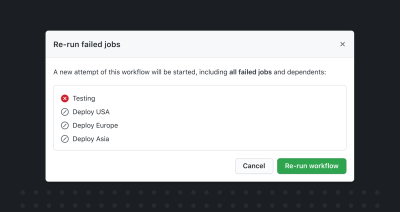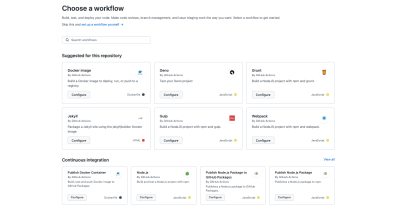
Achieving SLSA 3 Compliance with GitHub Actions and Sigstore for Go modules
Learn how to build packages with SLSA 3 provenance using GitHub Actions.

Learn how to build packages with SLSA 3 provenance using GitHub Actions.

From automating builds and releases to taking care of large-scale regression testing, here are a few ways we use GitHub Actions to build GitHub.

If you manage self-hosted runners for GitHub Actions, you can now specify shell scripts that run before the runner starts running a job from a workflow, and after a job…

You can now enforce consistent usage of self-hosted runner groups across your organization and enterprise.

You can now restrict self-hosted runner groups to only be accessible from certain workflows. In addition to restricting which repositories can access specific enterprise and organization runner groups, administrators can…

You can now re-run only failed jobs or an individual job in a GitHub Actions workflow run. For more details see Save time with partial re-runs in GitHub Actions on…

It is now possible to re-run only failed jobs or a single job in GitHub Actions workflows.

Support for Actions in internal repositories is now generally available for GitHub organizations owned by an enterprise account. You can innersource automation by sharing Actions in internal repositories, without publishing…

GitHub code scanning supports a wide variety of code analysis engines through GitHub Actions workflows — including our own CodeQL engine. Users can now discover and configure Actions workflow templates…

Reusable workflows offer a simple and powerful way to avoid copying and pasting workflows across your repositories.

A quick guide on the advantages of using GitHub Actions as your preferred CI/CD tool—and how to build a CI/CD pipeline with it.

You now have more control over when your self-hosted runners perform software updates. If you specify the –disableupdate flag to the runner then it will not try to perform an…

The dependency graph now supports detecting GitHub Actions workflow YAML files. These will be displayed within the dependency graph section in the Insights tab. Repositories that publish actions will also…

The dependency graph helps developers and maintainers understand the code they depend on, and now includes GitHub Actions!

You can now reference local reusable workflows more easily. With this release, reusable workflows that are in the same repository as the calling repository can be referenced with just the…

If your GitHub organization is owned by an enterprise account, you can now innersource automation by sharing Actions only within your enterprise without publishing them publicly. You can store the…

We’re excited to announce the V4 release of the OpenSSF’s Scorecard project in partnership with Google.

We have introduced a new policy setting that controls whether GitHub Actions can approve pull requests. This protects against a user using Actions to satisfy the “Required approvals” branch protection…

While renewing GitHub Actions SSL certificates, an unexpected change in the intermediate certificate authority broke workflows using Open ID Connect (OIDC) based deployment to AWS. To fix the issue please…

Windows Server 2022 became generally available on GitHub-hosted runners in November 2021. Over the next 8 weeks, jobs using the windows-latest runner label will migrate from Windows Server 2019 to…

Previously, when running a job that requires a self-hosted runner, GitHub Actions would look for self-hosted runners in the repository, organization, and enterprise, in that order. We are changing that…
Build what’s next on GitHub, the place for anyone from anywhere to build anything.
Catch up on the GitHub podcast, a show dedicated to the topics, trends, stories and culture in and around the open source developer community on GitHub.